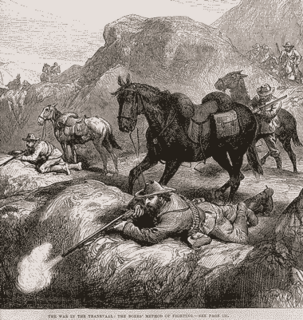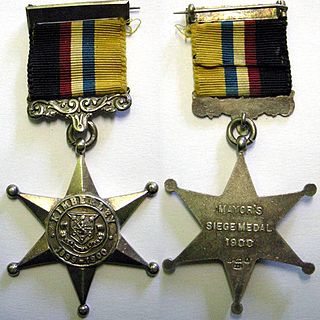
Boer is Dutch and Afrikaans for "farmer". In South African contexts, "Boers" refers to the descendants of the proto-Afrikaans-speaking settlers of the eastern Cape frontier in Southern Africa during the 18th and much of the 19th century. From 1652 to 1795 the Dutch East India Company controlled this area, but the United Kingdom incorporated it into the British Empire in 1806.

The South African Republic was an independent and internationally recognised state located in what is now South Africa, from 1852 to 1902.

The Second Boer War was fought between the British Empire and two Boer states, the South African Republic and the Orange Free State, over the Empire's influence in South Africa. It is also known variously as the Boer War, Anglo-Boer War, or South African War. Initial Boer attacks were successful, and although British reinforcements later reversed these, the war continued for years with Boer guerrilla warfare, until harsh British counter-measures brought the Boers to terms.

Artifacts indicating human activity dating back to the early Stone Age have been found in the Kingdom of Eswatini. Prehistoric rock art paintings date from c. 25,000 B.C. and continuing up to the 19th century can be found in various places around the country.

The first modern humans are believed to have inhabited South Africa more than 100,000 years ago. South Africa's prehistory has been divided into two phases based on broad patterns of technology namely the Stone Age and Iron Age. After the discovery of hominins at Taung and australopithecine fossils in limestone caves at Sterkfontein, Swartkrans, and Kromdraai these areas were collectively designated a World Heritage site. The first inhabitants of South Africa are collectively referred to as the Khoisan, the Khoi Khoi and the San separately. These groups were displaced or sometimes absorbed by migrating Africans (Bantus) during the Bantu expansion from Western and Central Africa. While some maintained separateness, others were grouped into a category known as Coloureds, a multiracial ethnic group which includes people with shared ancestry from two or more of these groups: Khoisan, Bantu, English, Afrikaners, Austronesians, East Asians and South Asians. European exploration of the African coast began in the 13th century when Portugal committed itself to discover an alternative route to the silk road that would lead to China. In the 14th and 15th century, Portuguese explorers traveled down the west African Coast, detailing and mapping the coastline and in 1488 they rounded the Cape of Good Hope. The Dutch East India Company established a trading post in Cape Town under the command of Jan van Riebeeck in 1652, European workers who settled at the Cape became known as the Free Burghers and gradually established farms in the Dutch Cape Colony.

The Transvaal Colony was the name used to refer to the Transvaal region during the period of direct British rule and military occupation between the end of the Second Boer War in 1902 when the South African Republic was dissolved, and the establishment of the Union of South Africa in 1910. The physical borders of the Transvaal Colony were not identical to the defeated South African Republic, but was larger. In 1910 the entire territory became the Transvaal Province of the Union of South Africa.

The Orange Free State was an independent Boer sovereign republic in Southern Africa during the second half of the 19th century, which ceased to exist after it was defeated and surrendered to the British Empire at the end of the Second Boer War in 1902. It is the historical precursor to the present-day Free State province.

The Great Trek was an eastward migration of Dutch-speaking settlers who travelled by wagon trains from the Cape Colony into the interior of modern South Africa from 1836 onwards, seeking to live beyond the Cape’s British colonial administration. The Great Trek resulted from the culmination of tensions between rural descendants of the Cape's original European settlers, known collectively as Boers, and the British Empire. It was also reflective of an increasingly common trend among individual Boer communities to pursue an isolationist and semi-nomadic lifestyle away from the developing administrative complexities in Cape Town. Boers who took part in the Great Trek identified themselves as voortrekkers, meaning "pioneers", "pathfinders" in Dutch and Afrikaans.

The First Boer War, also known as the First Anglo-Boer War, the Transvaal War or the Transvaal Rebellion, was a war fought from 16 December 1880 until 23 March 1881 between the United Kingdom and Boers of the Transvaal. The war resulted in Britain’s accession to the establishment of the Second Republic.

The Boer Republics were independent, self-governed republics in the last half of the nineteenth century, created by the Dutch-speaking inhabitants of the Cape Colony and their descendants, variously named Trekboers, Boers and Voortrekkers in mainly the middle, northern and north eastern and eastern parts of what is now the country of South Africa. Two of the Boer Republics achieved international recognition and complete independence: the South African Republic and the Orange Free State. The republics did not provide separation of church and state, and initially only the Dutch Reformed Church, then also other churches in the Calvinist Protestant tradition, were allowed. The republics came to an end after the Second Boer War which resulted in the British annexation and later incorporation into the Union of South Africa.

Franciscus "Frank" de Boer is a Dutch football manager who is currently the head coach of Atlanta United. A former defender, De Boer spent most of his professional playing career with Ajax, winning five Eredivisie titles, two KNVB Cups, three Super Cups, one UEFA Cup, one UEFA Champions League and one Intercontinental Cup. He later spent five years at Barcelona, where he won the 1998–99 La Liga title, before retiring after short spells at Galatasaray, Rangers, Al-Rayyan and Al-Shamal.

The Siege of Mafeking was a 217-day siege battle for the town of Mafeking in South Africa during the Second Boer War from October 1899 to May 1900. The siege received considerable attention as Lord Edward Cecil, the son of the British prime minister, was in the besieged town, as also was Lady Sarah Wilson, a daughter of the Duke of Marlborough and aunt of Winston Churchill. The siege turned the British commander, Colonel Robert Baden-Powell, into a national hero. The Relief of Mafeking, while of little military significance, was a morale boost for the struggling British.

The Natalia Republic was a short-lived Boer republic founded in 1839 after a Voortrekker victory against the Zulus at the Battle of Blood River. It was previously named Natália by Portuguese sailors. The republic came to an end in 1843 when British forces annexed it to form the Colony of Natal. After the British annexation of the Natalia Republic, most local Voortrekkers trekked north into Transorangia, later known as the Orange Free State, and the South African Republic.

The Battle of Spion Kop was fought about 38 km (24 mi) west-south-west of Ladysmith on the hilltop of Spioenkop(1) along the Tugela River, Natal in South Africa from 23–24 January 1900. It was fought between the South African Republic and the Orange Free State on the one hand and British forces during the Second Boer War campaign to relieve Ladysmith. It resulted in a Boer victory.

The Boer goat is a breed of goat that was developed in South Africa in the early 1900s and is a popular breed for meat production. Their name is derived from the Afrikaans (Dutch) word boer, meaning farmer.

The raccoon, sometimes spelled racoon, also known as the common raccoon, North American raccoon, or northern raccoon, is a medium-sized mammal native to North America. The raccoon is the largest of the procyonid family, having a body length of 40 to 70 cm and a body weight of 5 to 26 kg. Its grayish coat mostly consists of dense underfur which insulates it against cold weather. Three of the raccoon's most distinctive features are its extremely dexterous front paws, its facial mask, and its ringed tail, which are themes in the mythologies of the indigenous peoples of the Americas. Raccoons are noted for their intelligence, with studies showing that they are able to remember the solution to tasks for at least three years. They are usually nocturnal and omnivorous, eating about 40% invertebrates, 33% plants, and 27% vertebrates.
Afrikaners are a Southern African ethnic group descended from predominantly Dutch settlers first arriving at the Cape of Good Hope in the 17th and 18th centuries. They traditionally dominated South Africa's politics and commercial agricultural sector prior to 1994. Afrikaans, South Africa's third most widely spoken home language, evolved as the mother tongue of Afrikaners and most Cape Coloureds. It originated from the Dutch vernacular of South Holland, incorporating words brought from the Dutch East Indies and Madagascar by slaves. Afrikaners make up approximately 5.2% of the total South African population based on the number of white South Africans who speak Afrikaans as a first language in the South African National Census of 2011.

The Namaqua Copper Company 0-4-2STPioneer of 1901 was a South African steam locomotive from the pre-Union era in the Cape of Good Hope.

In the Colonies and Boer Republics which became the Union of South Africa in 1910, several unofficial military decorations and medals were instituted and awarded during the nineteenth and early twentieth century. The Kimberley Star is an unofficial private campaign medal which was instituted by the Mayor of Kimberley in 1900. The medal was awarded to all who took part in the defence of the diamond mining town during the four months in 1899 and 1900 while Kimberley was besieged by Boer Republican Forces during the Second Boer War.

The Royal Artillery Boer War Memorial is located on The Mall in Central London. It marks the deaths of the 1083 soldiers of the Royal Artillery who died in the Second Boer War of 1899 to 1902 and was unveiled by Prince Arthur, Duke of Connaught in July 20 1910. It has been Grade II* listed on the National Heritage List for England since February 1970. The heritage listing describes the monument as "a war memorial of clear architectural and sculptural quality, designed by two well-respected artists".




















